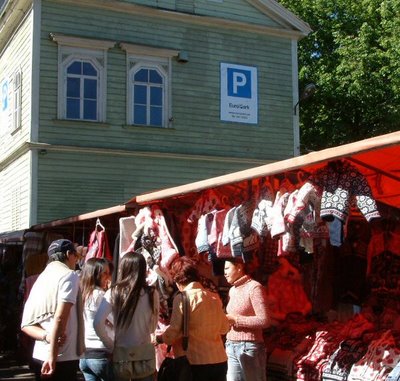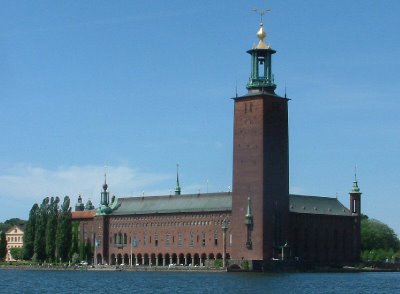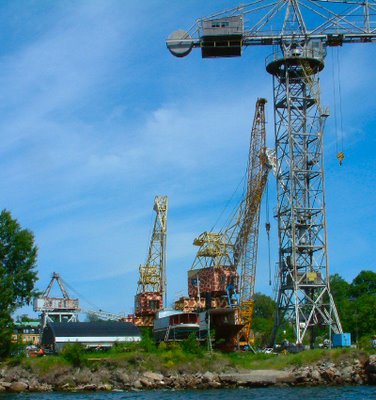This blog recounts our 2006 cruise to the Baltic.
A slightly more formal account, with a selection of the best photographs is being compiled at 2006 Cruise similar to the account of our 2005 Cruise to Ireland, Greenland, Iceland and Norway.
Here my intention is to describe the journey more informally and share some of the still interesting but possibly less spectacular photos.
The nature of the blog means that it is much more open to comments and I hope visitors will share their own experiences.
I apologise to readers for the fact that so far I have only recounted just over half the journey, but I do intend to continue this as soon as I have time.
Tuesday, July 01, 2008
Saturday, June 17, 2006
The Band
Morning Call in St Petersburg

I am half asleep yet can hear a band playing. Has someone switched on the TV? the bedside clock reads 7.00am. I draw back the curtains and peer through the porthole. We have arrived in Saint-Petersburg. We are being serenaded by a brass band on the dock.
Friday, June 16, 2006
Aurora at Tallinn
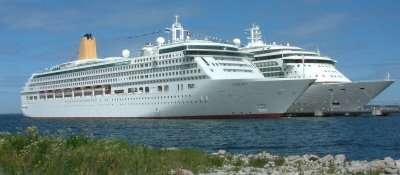
Before returning to the ship I visit a trailer that is parked at the port. It is selling chocolates. Kalev Chocolates started under that name in 1948 but the confectionary business in Tallinn can be traced back to 1806. For €5 I get a 185 gr box which carries an 1830 picture by Joseph Steingrübeli of the Town Hall.
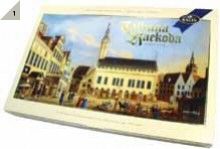
The bear enigma

I've had a good long walk around this fascinating city. Uus and Aia are strange streets that feature a few old buildings but also shops, carparks, apartments and the general small stuff found almost everywhere in the world.
Kanutiaed is one of a number of stretches of tranquil parkland dotted around the edge of town. Here there is a tramp asleep, a couple of giggly schoolgirls, a young mum with her baby in a pram. I sit for a while on a bench and watch the shuttle buses come and go.
Shortly I catch one back to the Port of Tallinn. Here lies an enigma. Dominating the skyline, but not encroaching on the view of the town, is a sculpture of a bear. Notices I saw as we passed by on the bus, seem to indicate that this is the site of an Historical Theme Park, yet I've been unable to find any definitive information about it. From its location, I suspect the building was originally the Tallinn City Concert Hall.
Mediaeval Houses
Merchant's House at 23 Vene
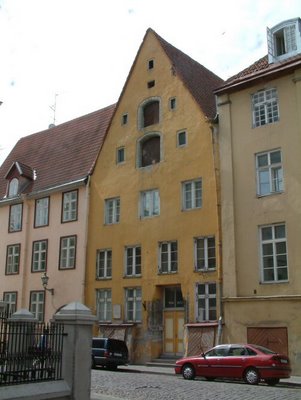
Almost opposite the church is the Linna Muuseum at 17 Vene.
The museum building has been heavily restored, whilst nearby at 23 Vene lies an unrestored Merchant's House.
Deerhound
St Nicholas' Church

I walk back into the 21st century and pick my way through some offices which I only later learn were once the HQ of the local KGB. I pass a Russian Museum and a tattoo parlour before coming upon the Russian Orthodox Church of St Nicholas.
Labels:
churches,
KGB,
Russian Orthodox,
St Nicholas,
Tallinn,
tatoos
Laboratooriumi
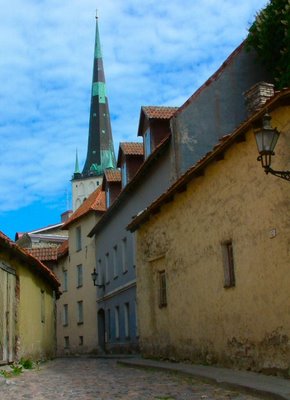
I find myself in Laboratooriumi. It is so quiet. There is nothing modern here at all. Grass grows in cracks under wooden doors. The old colour-washed walls are grimy and woe-begone. I am totally alone and feel in a time-warp. Is this the fifteenth century I'm stood in?
Towering above the end of the street is the spire of St Olav's Church. At just over 400ft it is the tallest of the city's spires. In the 1500s it was the tallest building in the world at that time.
Labels:
churches,
Laboratooriumi,
spire,
St Olav's Church,
Tallinn,
walls
Loewenschade Torn

I follow the walls past Loewenschade Torn and then pass under them into a courtyard that leads to a street called Aida.
Labels:
Aida,
courtyard,
Loewenschade Torn,
Tallinn,
walls
Suur Kloostri

I rest briefly in a quiet park, Tornideväljak before returning back towards the walls along Suur Kloostri.

Labels:
parks,
Suur Kloostri,
Tallinn,
Tornideväljak,
walls
Up Viru

I continue up Viru which is thronged with people. Girls in national costume hand out leaflets about a local restaurant. The Town Hall square is a mass of stalls.
I continue up towards the Town Walls and a place called Pikk Jalg which means the long leg street. Here is an archway under the walls and the steep climb to Toompea Castle.
I decide not to continue upwards but turn right into Nunne. Suddenly I'm away from all the noise and in a quiet street that leads below the walls. Looking up I can see people looking down from the Kohtu viewing platform.
Sauna

Turning off the busy Viru, I find almost deserted, narrow alleyways such as Sauna. The name of the street probably means small farm though it could mean bath-house.
Cycle taxi
Mural at the corner of Aia and Viru

Later I take the shuttle back into Tallinn on my own. Viru gate is now even busier than earlier. At the corner of Aia and Viru is an interesting mural. The upper part seems to be a map, whilst the bottom part is in two halves, one a scroll of writing whose significance is lost on me and the other looks as if it could be an advert for an ice-cream parlour.
I venture into a jewelers shop, looking for a suitable gift for Christine, it being our wedding anniversary in a weeks time. I look at some amber necklaces and ask the price in euros. I translate the price into pounds. Thereafter the assistant quotes me prices in sterling. Having settled on a suitable purchase I decide to pay using my credit card. This seems to be the best option since the card is debited in Estonian kroon and my bank does the conversion into sterling later.
Sugared Almonds

In the corner is a hand-cart selling sugared almonds. The girls in national costume belong to the Olde Hansa Restaurant. Resisting their charms, we get the shuttle bus back to the ship for lunch.
Labels:
almonds,
costumes,
food,
Olde Hansa Restaurant,
Tallinn
Viru Gate
Tammsaare Park
Tram
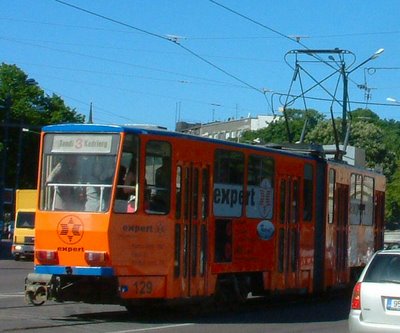
We cross the busy main street with its lorries, cars and trams trundling past and head into the modern part of Tallinn.
There is some building work going on near what we later discover is the Tallinn post office. These modern glass and concrete structures don't really reveal that inside are shopping centres and offices, so uninvited we don't venture in.
At first I thought this was actually a trolley-bus but a commentator has corrected me.
Matrushka Dolls

We set off down the street and soon come to a handicraft market, where there are various stalls. One of them has a selection of Matrushka Dolls. Christine has been fancying one for years. We get a good-sized 10-doll set. These are not traditional Estonian souvenirs as they emanate from Russia, but similar dolls in Russia are at least double the price and those on the ship are even dearer. We only see them for a comparable price in Helsinki.
Shuttle bus

We are pleased to be told that one of the shuttle buses has a ramp and so Christine can get her wheelchair on to it.
After a bit of a wait for the bus to fill up, it takes us on the ten minute journey into the city, dropping us off near the Hotel Viru.
Two ships

The next morning we arrive in Tallinn, the capital of Estonia.
It is a lovely morning. As we emerge into the sunshine, we discover an American cruise ship is berthed alongside us.
At the end of the long pier we are given some postcards and a map of the city by a girl belonging to the local Tourism office.
Thursday, June 15, 2006
Bendiebuses
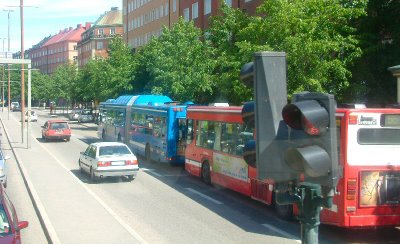
On the road out of Stockholm we pass a number of bendiebuses. These double-jointed buses seem to be common in many parts of Europe, but are probably too long to be seen on narrow British roads. Some of them are labelled Biogasbus.
At Nynäshamn, before catching the tender back to the boat, I look in a small hut which belongs to the Nynäshamn Tourist Information. I was wanting to get a present for Christine and perhaps a souvenir. One item priced at SKr150 and another at SKr55 attract my attention. They seem a little over-priced in any case. I ask if I can have the two for SKr200 as I don't want to get any small change. They refuse my offer so I put the banknote back in my pocket. I'll convert it into Norwegian kroner later in the trip.
Dog in the shade
Fjallgatan
Riddarholmen Church

Behind us is the magnificent steeple of Riddarholmen Church. It was the final resting place of the Swedish kings and Stockholm's only preserved medieval monastery church. With the one exception of Queen Christina, all succeeding rulers of Sweden from Gustav II Adolf (d. 1632) to Gustaf V (d. 1950) are buried in the Riddarholmen Church.
Labels:
churches,
Gustav,
Queen Christina,
Riddarholmen,
steeple,
Stockholm
Mälardrottningen

We finally stop on Riddarholmen, next to Mälardrottningen, another old ship which is now a hotel and restaurant.
Labels:
hotels,
Mälardrottningen,
Riddarholmen,
ships,
Stockholm
City Fountain
Kungsgatan
Birger Jarlsgaten
Berzelii Park

We drive past Berzelii Park, which in the hot summer of 1951, was the scene of the so called Berzelii Riots, when bored, and often drunk young people gathered in the park night after night. The continuing riots escalated and reached their peak on the night of August 26, when there was a stand off between 3000 young people and policemen called in from five different cites, including military police.
Now it looks so peaceful.
National Museum

We sail in past the National Museum before landing back near the Grand Hôtel where our coach is waiting.
Labels:
coach,
Grand Hotel,
hotels,
museums,
National Museum,
Stockholm
af-Chapman

Passing the island of Skeppsholmen we see af-Chapman, a fine three-masted sailing ship.
Seemingly it entered service as the Dunboyne in 1888 and once carried passengers between Ireland and Australia. During World War II it was a Swedish Navy barracks ship.
Since 1949 however it has been used as a Youth Hostel
Labels:
af-Chapman,
Australia,
boats,
Dunboyne,
hotels,
Ireland,
islands,
Navy,
Second World War,
Skeppsholmen,
Stockholm,
Youth Hostel
Gröna Lund Tivoli

As the boat turns to sail back towards our starting point, we get a good view of the Gröna Lund Tivoli.
Giraffe Cranes
Mill at Waldemarsudde

Waldemarsudde is the home of Prince Eugen. The prince was an artist who painted the Swedish landscape and the Nordic light during the late 19th and early 20th century. A picture gallery was added in 1913. Today it is a museum where one can view both the prince's home and his art collection.
In the gardens of Waldemarsudde is an old mill.
Manilla
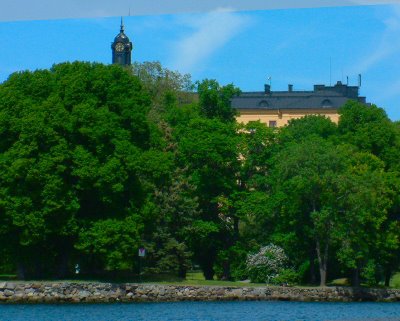
The building that we see behind the trees is Manilla. It was built in the 1770s, named after the capital founded by Spain in the Philippines by The Spanish Minister Ignacio de Coral who enlarged the area. The Public Institute for the Deaf and Dumb and Blind or Manillaskolan was founded here in 1819 by P.A. Borg.
Labels:
Art Galleries,
museums,
Prince Eugen,
Stockholm,
Waldemarsudde
Täcka Udden
Blockhusudden
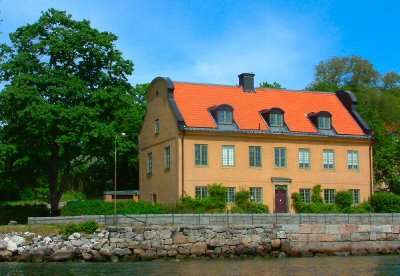
Beyond the canal we are in the main shipping channels for the ferries that ply between Stockholm and outer islands such as Vaxholm.
Off Blockhusudden on the SE corner is one of the world's first automatic navigation lights, manufactured by AGA in 1905 and now electrified.
We pass Thielska Galleriet, a white, green-domed mansion, designed by Ferdinand Boberg and built for bank director Ernst Thiel in 1905. It houses the art collection which he assembled and the picture gallery is open to the public.
Labels:
Art Galleries,
Blockhusudden,
Boberg,
Fair Point,
ferry,
houses,
lighthouse,
Manilla,
schools,
Stockholm,
Täcka Udden,
Thiel,
Vaxholm,
Wallenberg
Subscribe to:
Comments (Atom)










